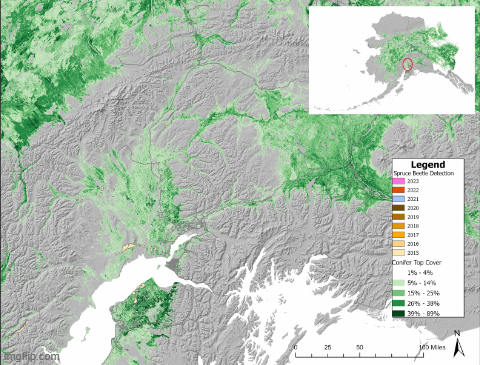
NPS Illustration / M. Perez Spruce beetle move across the landscape by dispersing through the air. They may fly from tree to tree on their own power or be aided by the wind. Under endemic population levels, beetles are attracted to trees under stress. However, when populations are high, beetles may be relegated to attacking healthy trees. In the Denali area, the beetle outbreak has primarily spread from the south. It is likely that suitable climate conditions and a smaller-scale disturbance event (i.e., a localized wind-throw event) instigated rapid beetle population growth in south-central Alaska beginning around 2015. The outbreak has since spread in all directions with suitable host trees. Year-by-year, the pulse of high beetle population has moved the leading edge of spruce mortality farther north. Once the outbreak reached the Alaska Range, frequent and strong southern winds aided the spread of large numbers of spruce beetle into the park. Interestingly, some beetles seem to have caught a ride over treeless high elevation passes, only to settle in to attack the first trees they hit at treeline on the other side. In the Denali area, D. rufipennis typically follow a 1 or 2-year life cycle. In a 1-year life cycle, female beetles enter and lay eggs in their host tree between May and June. The eggs hatch and the larvae begin to feed. By July or August, larvae reach the pupal stage— a period of inactivity in which an insect transitions from larva to adult. Once the transition is complete, the adult beetle will overwinter in the host tree until the following summer. As the early summer sun warms the bark, the adult beetle wakes up, looks for a new host tree, lays eggs, and the lifecycle starts anew. In a 2-year life cycle, the larval feeding and transition to pupal stage may take longer. Larvae may be more vulnerable to freezing overwinter, and egg hatching may be delayed. For beetles that follow a 2-year life cycle, patterns in weather from season to season can have a big effect on survival. For example, an early warm spring followed by a mild winter may allow beetle populations to abruptly increase. On the contrary, one long and severe cold snap followed by a late or cold spring may inhibit survival of many of the beetles. 
Information here was summarized from: USDA Forest Service, Alaska Department of Natural Resources-Division of Forestry & Fire Protection, and UAF-Cooperative Extension Service. 2024. Spruce Beetle in Alaska's Forests – Information regarding spruce beetles in Alaska. USDA Forest Service, Forest Health Protection and its partners. 2024. Alaska's Aerial Detection Survey. USDA Forest Service, Forest & Grassland Health. Macander, M.J., Nelson, P.R., Nawrocki, T.W., Frost, G.V., Orndahl, K.M., Palm, E.C., Wells, A.F., and S.J. Goetz. 2022. Time-series maps reveal widespread change in plant functional type cover across Arctic and boreal Alaska and Yukon. Environmental Research Letters 17 054042. |
Last updated: April 14, 2025
